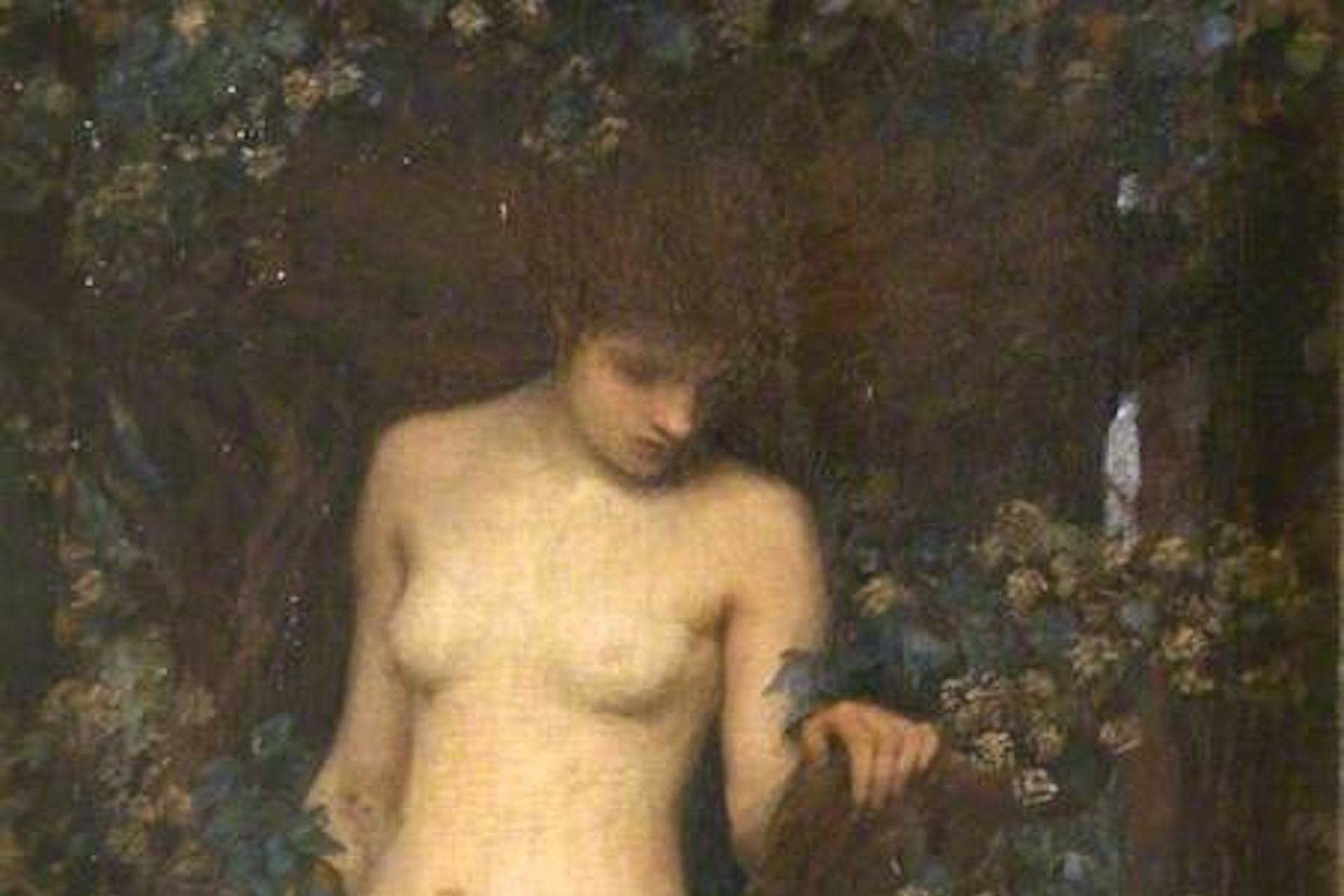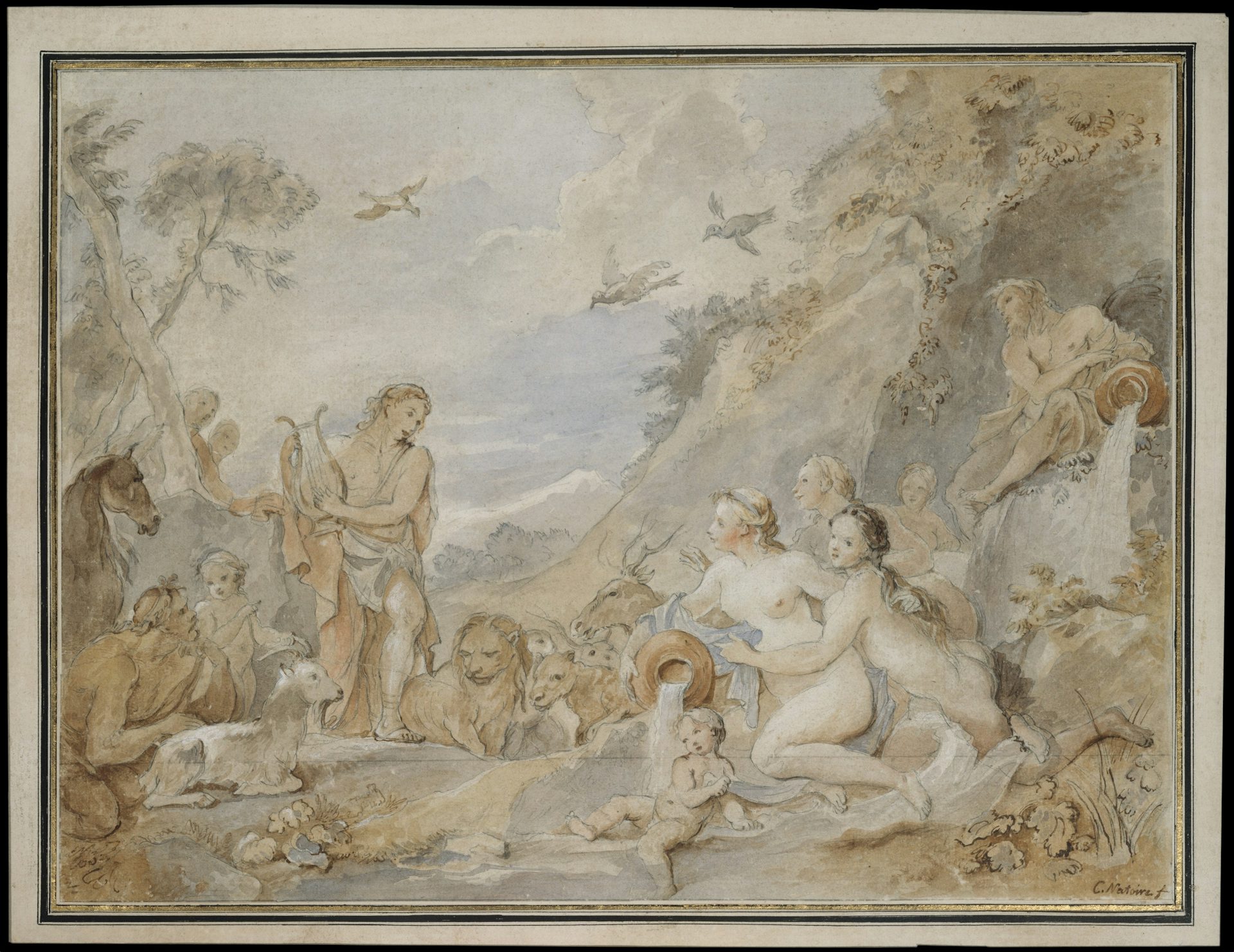Dryads and Hamadryads

Hamadryad (detail) by John William Waterhouse (1893 or 1895)
Plymouth City Museum and Art Gallery, DevonPublic DomainOverview
Dryads and Hamadryads were nymphs—minor female divinities who represented various aspects of nature. Originally, Dryads and Hamadryads formed two different categories of nymphs connected with oak trees (both terms come from the ancient Greek word for “oak tree”). While Dryads simply lived near trees, Hamadryads actually lived inside their trees and even died when their trees died. Over time, however, the two groups were conflated, and they came to be seen as tree nymphs in general, rather than nymphs of oak trees specifically.
In their myths, both Dryads and Hamadryads were closely connected with trees, groves, and forests; their greatest threats were natural disasters or mortals who uprooted their beloved trees. Some Dryads and Hamadryads were also the lovers or mothers of important mythological figures, while others gave their names to local landmarks or settlements. Unlike other nymphs, though, Dryads and Hamadryads do not seem to have been worshipped by the Greeks.
Etymology
The terms “Dryad” (Greek Δρυάς, translit. Dryás; pl. Dryads, Greek Δρυάδες, translit. Dryádes)[1] and “Hamadryad” (Greek Ἁμαδρυάς, translit. Hamadryás; pl. Hamadryads, Greek Ἁμαδρυάδες, translit. Hamadryádes)[2] share a similar etymology: both come from the Greek word δρῦς (drûs), meaning “oak tree.”
“Hamadryad,” however, includes the additional element ἅμα (hama), a Greek prefix meaning “together.” This seems to reflect an early distinction between Dryads and Hamadryads, in which Hamadryads literally lived and died “together” with their tree, while Dryads could live separately from their trees or migrate from one tree to another. Eventually, the terms “Dryad” and “Hamadryad” seem to have become interchangeable.
Dryads and Hamadryads could also be called Ἁδρυάδες (Hadryádes)[3] or Ἀδρυάδες (Adryádes).[4]
Pronunciation
English
Greek
Dryad, Dryads; Hamadryad, Hamadryads Δρυάς, Δρυάδες (Dryás, Dryádes); Ἁμαδρυάς, Ἁμαδρυάδες (Hamadryás, Hamadryádes) Phonetic
IPA
[DRAHY-uhd, DRAHY-uhdz]; [ham-uh-DRAHY-uhd, ham-uh-DRAHY-uhdz] /ˈdraɪ əd, ˈdraɪ ədz/; /ˌhæm əˈdraɪ əd, ˌhæm əˈdraɪ ədz/
Attributes
Dryads and Hamadryads were nymphs, beautiful female deities connected with the natural world. Their parents were often nature gods, such as river gods or other nymphs. Because their names come from the Greek word meaning “oak tree,” it seems that both Dryads and Hamadryads were originally connected with oak trees in particular. Over time, however, Dryads and Hamadryads came to be regarded as nymphs of trees in general.[5]

Orpheus Charming the Nymphs, Dryads, and Animals by Charles Joseph Natoire (1757)
The Metropolitan Museum of ArtPublic DomainAt first, Dryads and Hamadryads were distinguished not only from other tree nymphs (such as Meliae, the nymphs of ash trees) but also from one another. While Dryads, like most other tree nymphs, simply lived in forests or around trees, Hamadryads were born, lived, and died in their trees. This was a very ancient tradition, described by the author of the fifth Homeric Hymn (also known as the Homeric Hymn to Aphrodite):
… at their birth pines or high-topped oaks spring up with them upon the fruitful earth, beautiful, flourishing trees, towering high upon the lofty mountains (and men call them holy places of the immortals, and never mortal lops them with the axe); but when the fate of death is near at hand, first those lovely trees wither where they stand, and the bark shrivels away about them, and the twigs fall down, and at last the life of the Nymph and of the tree leave the light of the sun together.[6]
This hymn does not explicitly refer to the nymphs who died with their trees as Hamadryads (the earliest use of the term comes from an author living several centuries later, Apollonius of Rhodes). But later authorities specified things more clearly: Hamadryads lived and died with their trees, while Dryads simply lived near trees.[7]
This belief in trees as living beings, or even beings with a soul, was apparently an old one. Some sources even made references to bleeding trees—presumably reflecting the same belief embodied by the mythical Hamadryads.[8]
Yet the distinction between Dryads who lived near trees and Hamadryads who lived inside them seems to have faded over time; later sources speak of Hamadryads who were able to leave their tree when it died and continue living.[9] In other words, Dryads and Hamadryads became interchangeable terms for tree nymphs.
Mythology
Origins
Little can be said with certainty about the origins of the Dryads and Hamadryads. The terms first appear in Apollonius of Rhodes’ Argonautica (third century BCE), which mentions Hamadryads.[10]
But the idea of nymphs who lived and died with their trees can already be found in the fifth Homeric Hymn (the Homeric Hymn to Aphrodite), possibly composed as early as the seventh century BCE. Hesiod, another poet of the seventh century BCE (or thereabouts),[11] describes a related category of tree nymphs, the Meliae, who were nymphs of ash trees.
Unlike the Meliae and many other groups of nymphs, the Dryads and Hamadryads do not seem to have enjoyed a common ancestor. Instead, they were usually described as the daughters of local gods, rivers, or other nymphs.
Nymphs and their Trees
Saviors of the Nymphs: Arcas and Rhoecus
There are a few myths about tree nymphs whose trees—and lives—were saved by helpful mortals.
One such myth involves Arcas, the ancestor and namesake of the Arcadians of central Greece. In one version of the tale, the tree of a Hamadryad named Chrysopoleia was in danger of being uprooted by a river that had flooded. Arcas, who happened to be hunting nearby, saved Chrysopoleia and her tree by rerouting the river. Chrysopoleia ended up marrying Arcas and giving him two children, Elatus and Apheidas.[12]
In another version, however, the nymph saved by Arcas was not the Hamadryad Chrysopoleia but rather a Dryad named Erato. This Erato, it was said, was a priestess of the rustic god Pan in his temple at Megalopolis. She was thought to have written several prophecies that were kept in this temple. Erato gave Arcas three children, named Elatus, Apheidas, and Azan.[13]
A more obscure myth is that of Rhoecus. This Rhoecus, a mortal man living somewhere in the east, saw an oak tree that was about to fall and propped it up. The nymph of the oak tree was grateful to Rheocus for saving her life and asked him what he desired as a reward. Rhoecus replied that he wanted to sleep with the nymph. She consented, but only on the condition that Rheocus forgo all other women. The lovers were known to send each other messages using a bee.
But Rhoecus offended the nymph somehow (either by speaking rudely or by cheating on her, depending on the source). He was then punished, possibly by the aforementioned bee (the details of his punishment are unclear from the sources).[14]
Enemies of the Nymphs: Erysichthon and Paraebius
There are a handful of myths that describe the intimate relationship between certain nymphs (such as Dryads and Hamadryads) and their trees. Perhaps the most famous of these is the myth of Erysichthon.
Erysichthon was a somewhat brutish king from Thessaly in northern Greece. One day he went into the woods and cut down a tree that was sacred to Demeter, the Olympian goddess of agriculture, and the nymphs (one source even specifies that these were Dryad nymphs). Grief-stricken, the nymphs prayed to Demester to punish the man:
Terrified and shocked,
the sister-dryads, grieving for the grove
and what they lost, put on their sable robes
and hastened unto Ceres, whom they prayed,
might rightly punish Erysichthon’s crime…[15]
Demeter did as the nymphs asked and punished the irreverent Erysichthon: she afflicted him with an insatiable hunger, so that no matter how much he ate he would still be hungry. Eventually, Erysichthon’s hunger drove him to devour himself.[16]

The Woodcutter and the Hamadryad Aigeiros by Émile Bin (1870)
Musée Thomas-Henry, Manche, FrancePublic DomainA similar (though lesser-known) myth has a happier ending. It tells of a certain mortal named Paraebius whose father had cut down a nymph’s tree, despite her warnings. This did not kill the nymph but merely angered her, leading her to put a terrible curse on the man and his descendants. But Paraebius was able to remove the curse by erecting an altar to the nymph.[17]
Other Myths
Some Dryads and Hamadryads were known as the consorts or mothers of important mythological individuals. Arcas, as we have seen, married either a Dryad or a Hamadryad. Similarly, Danaus, the ancestor of the Greek tribe known as the Danaans, had two Hamadryads—Atlantia and Phoebe—among his many wives.[18]
Other Dryads and Hamadryads were honored by local people, who named towns or cities after them. For instance, the town of Phigalia in Arcadia was believed to have been named after a Dryad named Phigalia.[19]
Worship
There is very little evidence that Dryads or Hamadryads were regularly worshipped in ancient Greece. There are, however, a few references in Greek literature to gifts or prayers offered to these tree nymphs, whether to atone for some offense or to seek general good fortune.[20]
Pop Culture
Modern pop culture has not completely forgotten Dryads and Hamadryads. References to these nymphs and their trees can be found in literary works by authors as diverse as Edgar Allen Poe, Ezra Pound, Sylvia Plath, and C. S. Lewis, among others. Dryads and Hamadryads have also appeared in film and television—for example, in the TV show Xena: Warrior Princess (where they are reimagined as flying, Harpy-like skeletons)—as well as in games such as Magic: The Gathering.